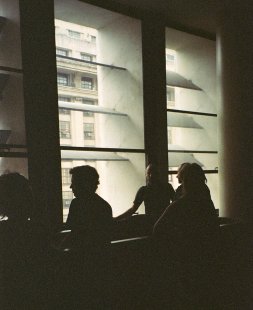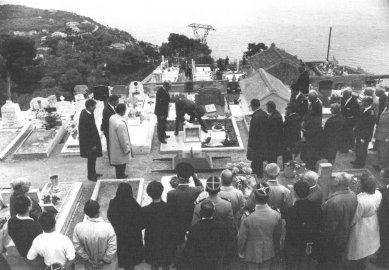
Marie Davidová : Breathing Walls in Architectural Performance
On Wednesday May 16, 2018 at 5:00 PM in room B510 at the Faculty of Architecture VUT in Brno, Poříčí 5, there will be a lecture by architect Marie Davidová from the Prague studio Collaborative Collective, which will analyze the influence of climate on the architecture of Lucio Costa and Le Corbusier. At 6:00 PM, there will be a follow-up lecture by Petr Šmídek titled "Le Corbusier after Le Corbusier", reflecting on the last moments of Le Corbusier's life and the influence on subsequent generations, thereby concluding the fourteen-part spring cycle "Moi et LeC".
Marie Davidová, MArch, Ph.D. completed her master's studies at AHO in Oslo, worked at the Snøhetta studio, and co-founded the Prague studio Collaborative Collective in 2007. Marie Davidová is engaged in research, focusing on the marginal properties of wood. She completed her doctoral studies in the studio of Miloš Florian at FA ČVUT and is currently a research scientist at FUA TU in Liberec.
Abstract:
The discussion about breathing walls starts with the theoretical work of David Leatherbarrow in the context of performance in architecture, and in relation to this topic, in the context of redirecting the understanding of the architectural profession (Leatherbarrow, 2009). Around the turn of the millennium, a committed discussion about the interaction of architecture with its environment begins, which specifically includes the process of permeability and ‘biotic and abiotic agencies’ through its boundaries (Addington, 2009; Addington & Schodek, 2005). At the same time, these authors, such as Addington, Leatherbarrow, Hensel, and others (Addington, 2009; Hensel, 2013; Leatherbarrow, 2009) predominantly reach for references from modernism, such as Costa, Le Corbusier, and similar figures, perhaps only due to the topic's acceptability by traditional society within the profession.
The referenced modernists likely approached this topic because of the political situation in countries with extreme climates at that time (some are not the subject of discussion). Given the evident entry into a different climatic, eco-systemic, and political situation, it is impossible to overlook the traditional influences of these countries. Direct references to breathing walls are fundamental and clear in Oriental, often Arab, architecture. As shown through personal mapping, it had a fundamental influence on Portuguese and Spanish architecture, which in turn significantly influenced Latin America.
However, we will not discuss the originality of the concept but its relevance, evolution, and adaptation to local conditions. The speaker will compare her ‘research by design’ research in this historical context due to the current critical increase in climate extremes in the Czech Republic (Czech Republic Ministry of the Environment & Czech Hydrometeorological Institute, 2015). Therefore, a single goal will be presented here: ‘adapting architecture and urban environments to climate change and thus supporting biodiversity’ through architecture. This again means another redirection of understanding of the architectural profession, as discussed in the author's dissertation, this approach was ratified by her as ‘Systemic Approach to Architectural Performance’ (Davidová, 2017).
References:
Addington, M. (2009). Contingent Behaviours. Architectural Design, 79(3), 12–17. https://doi.org/10.1002/ad.882
Addington, M., & Schodek, D. L. (2005). Smart Materials and Technologies in Architecture (1st ed.). Oxford: Architectural Press - Elsevier. Retrieved from https://bintian.files.wordpress.com/2013/01/smart-materials-new-technologies-for-the-architecture-design-professions.pdf
Czech Republic Ministry of the Environment, & Czech Hydrometeorological Institute. (2015). Strategie přizpůsobení se změně klimatu v podmínkách ČR / Strategy on Adaptation to Climate Change in the Czech Republic. (Centre for Environment at Charles University & Prague, Eds.) (1st ed.). Prague: Czech Republic Ministry of the Environment. Retrieved from http://www.mzp.cz/C1257458002F0DC7/cz/zmena_klimatu_adaptacni_strategie/$FILE/OEOK-Adaptacni_strategie-20151029.pdf
Davidová, M. (2017). Wood as a Primary Medium to Eco-Systemic Performance: A Case Study in Systemic Approach to Architectural Performance. Czech Technical University in Prague. https://doi.org/DOI10.13140/RG.2.2.17123.45607
Hensel, M. (2013). Performance-Oriented Architecture: Rethinking Architectural Design and the Built Environment (1st ed.). West Sussex: John Willey & Sons Ltd.
Leatherbarrow, D. (2009). Architecture Oriented Otherwise. New York: Princeton Architectural Press.
More information >
Marie Davidová, MArch, Ph.D. completed her master's studies at AHO in Oslo, worked at the Snøhetta studio, and co-founded the Prague studio Collaborative Collective in 2007. Marie Davidová is engaged in research, focusing on the marginal properties of wood. She completed her doctoral studies in the studio of Miloš Florian at FA ČVUT and is currently a research scientist at FUA TU in Liberec.
Abstract:
The discussion about breathing walls starts with the theoretical work of David Leatherbarrow in the context of performance in architecture, and in relation to this topic, in the context of redirecting the understanding of the architectural profession (Leatherbarrow, 2009). Around the turn of the millennium, a committed discussion about the interaction of architecture with its environment begins, which specifically includes the process of permeability and ‘biotic and abiotic agencies’ through its boundaries (Addington, 2009; Addington & Schodek, 2005). At the same time, these authors, such as Addington, Leatherbarrow, Hensel, and others (Addington, 2009; Hensel, 2013; Leatherbarrow, 2009) predominantly reach for references from modernism, such as Costa, Le Corbusier, and similar figures, perhaps only due to the topic's acceptability by traditional society within the profession.
The referenced modernists likely approached this topic because of the political situation in countries with extreme climates at that time (some are not the subject of discussion). Given the evident entry into a different climatic, eco-systemic, and political situation, it is impossible to overlook the traditional influences of these countries. Direct references to breathing walls are fundamental and clear in Oriental, often Arab, architecture. As shown through personal mapping, it had a fundamental influence on Portuguese and Spanish architecture, which in turn significantly influenced Latin America.
However, we will not discuss the originality of the concept but its relevance, evolution, and adaptation to local conditions. The speaker will compare her ‘research by design’ research in this historical context due to the current critical increase in climate extremes in the Czech Republic (Czech Republic Ministry of the Environment & Czech Hydrometeorological Institute, 2015). Therefore, a single goal will be presented here: ‘adapting architecture and urban environments to climate change and thus supporting biodiversity’ through architecture. This again means another redirection of understanding of the architectural profession, as discussed in the author's dissertation, this approach was ratified by her as ‘Systemic Approach to Architectural Performance’ (Davidová, 2017).
References:
Addington, M. (2009). Contingent Behaviours. Architectural Design, 79(3), 12–17. https://doi.org/10.1002/ad.882
Addington, M., & Schodek, D. L. (2005). Smart Materials and Technologies in Architecture (1st ed.). Oxford: Architectural Press - Elsevier. Retrieved from https://bintian.files.wordpress.com/2013/01/smart-materials-new-technologies-for-the-architecture-design-professions.pdf
Czech Republic Ministry of the Environment, & Czech Hydrometeorological Institute. (2015). Strategie přizpůsobení se změně klimatu v podmínkách ČR / Strategy on Adaptation to Climate Change in the Czech Republic. (Centre for Environment at Charles University & Prague, Eds.) (1st ed.). Prague: Czech Republic Ministry of the Environment. Retrieved from http://www.mzp.cz/C1257458002F0DC7/cz/zmena_klimatu_adaptacni_strategie/$FILE/OEOK-Adaptacni_strategie-20151029.pdf
Davidová, M. (2017). Wood as a Primary Medium to Eco-Systemic Performance: A Case Study in Systemic Approach to Architectural Performance. Czech Technical University in Prague. https://doi.org/DOI10.13140/RG.2.2.17123.45607
Hensel, M. (2013). Performance-Oriented Architecture: Rethinking Architectural Design and the Built Environment (1st ed.). West Sussex: John Willey & Sons Ltd.
Leatherbarrow, D. (2009). Architecture Oriented Otherwise. New York: Princeton Architectural Press.
More information >
The English translation is powered by AI tool. Switch to Czech to view the original text source.


0 comments
add comment
Related articles
3
30.11.2022 | What is architecture? Lecture by Marie Davidová at the Faculty of Civil Engineering, Czech Technical University
0
09.05.2018 | Slavomíra Ferenčuhová: The Sociological Impact of Le Corbusier's Buildings
0
26.04.2018 | Patrik Líbal : Ancient Inspirations LeC
0
05.04.2018 | Jan Hanák: Spiritual Aspects of Le Corbusier's Late Work
0
04.04.2018 | Marie Gelová and Klára Stachová: Le Corbusier's Landscape
0
14.03.2018 | Jiří Tourek: Le Corbusier, the Mediterranean Myth and Us Today
0
21.02.2018 | Moi and LeC - spring lecture series on Le Corbusier










